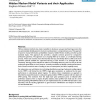Free Online Productivity Tools
i2Speak
i2Symbol
i2OCR
iTex2Img
iWeb2Print
iWeb2Shot
i2Type
iPdf2Split
iPdf2Merge
i2Bopomofo
i2Arabic
i2Style
i2Image
i2PDF
iLatex2Rtf
Sci2ools
BMCBI
2006
2006
Hidden Markov Model Variants and their Application
Markov statistical methods may make it possible to develop an unsupervised learning process that can automatically identify genomic structure in prokaryotes in a comprehensive way. This approach is based on mutual information, probabilistic measures, hidden Markov models, and other purely statistical inputs. This approach also provides a uniquely common ground for comparative prokaryotic genomics. The approach is an on-going effort by its nature, as a multi-pass learning process, where each round is more informed than the last, and thereby allows a shift to the more powerful methods available for supervised learning at each iteration. It is envisaged that this "bootstrap" learning process will also be useful as a knowledge discovery tool. For such an ab initio prokaryotic gene-finder to work, however, it needs a mechanism to identify critical motif structure, such as those around the start of coding or start of transcription (and then, hopefully more). For eukaryotes, even w...
| Added | 10 Dec 2010 |
| Updated | 10 Dec 2010 |
| Type | Journal |
| Year | 2006 |
| Where | BMCBI |
| Authors | Stephen Winters-Hilt |
Comments (0)

